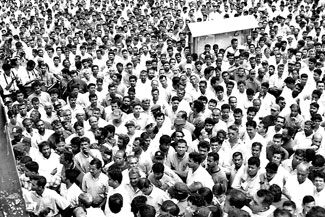Rising population is a problem faced by the world today. The United Nations have set apart one day in the year to reflect on this problem. Known as the World Population Day, it falls on July 11.
A theme is selected for the Population Day every year and the different activities are coordinated by the UNFPA, the United Nations Population Fund, an international
development agency that promotes the right of every man, woman and child to enjoy a life of health and equal opportunity. UNFPA
supports countries in using population data for policies and programmes to reduce poverty and to ensure that every pregnancy is wanted, every birth is safe, every young person is free of HIV/AIDS, and every girl and woman is treated with dignity and respect.
This year's theme is chance to build awareness of the importance of
educating girls on a wide range of development issues, including poverty, human rights and gender equality.
With the World Population Day falling this week, it is opportune to study some facts and
figures relating to world population. As of May 31, 2009, the world population is estimated by the United States Census Bureau to be 6,763,557,000
(6.7 billion). According to population projections, world population will
continue to grow until around 2050.
The 2008 rate of growth has almost halved since its peak of 2.2% per year, which was reached in 1963. World births have levelled off at about
137-million-per-year, since their peak at 163-million in the late 1990s, and are expected to remain
constant. However, deaths are only around 56 million per year, and are expected to increase to 90 million by the year 2050. Since births outnumber deaths, the world's population is expected to reach about
9 billion by the year 2040.
In the 20th century, the world saw the biggest increase in its population in human history due to lessening of the mortality rate in many countries due to medical advancement and a massive increase in
agricultural productivity attributed to the Green Revolution. Asia with 4,074 million has the biggest population followed by Africa
(973 million), Europe (732m), Latin America & Carribean (577m), North America (307m) and Oceania (34m).
As for the countries with the largest population, China is well ahead with a population of 1.3 billion. The world is made up of thousands of ethnic groups. The single largest ethnic group on the planet by far is Han Chinese, which represents 19.73% of the global population.
Around 27% of the world's population is below 15 years of age
As for Sri Lanka, according to the latest
estimates Sri Lanka has a population of about 20
million. The ethnic
division of the
population is: Sinhalese 74%, Tamil 18%, Moor 7%, Burgher, Malay and Veddah 1%.
Sri Lanka has a
literacy rate of 92% which means 92% of the
population can read and write. The population growth rate is 0.89%, while the birth rate is 15.6/1000. The infant mortality rate is 14.3/1000 and life expectancy 73.2 years.
A World Bank in-depth study report on
Sri Lanka's aging
population has revealed that the country is rated as the fastest aging
population in South Asia and that it's time for the policy makers take the matter seriously.
In its report the World Bank warned that
Sri Lanka will face a
massive social challenge to provide income, health and other types of support to its elderly population in just over two decades.
The report entitled, 'Addressing the Needs of an Aging Population' has predicted that the
country's population will grow to be as old as Europe or Japan's today, but will have a much lower level of income, posing a massive social challenge to provide services to its
elderly population.
The ten countries with the largest population are:
1 China 1,329,740,000 19.66%
2 India 1,145,174,000 16.94%
3 Eur.Union 499,673,000 7.39%
4 USA 305,924,270 4.53%
5 Indonesia 229,631,355 3.40%
6 Brazil 190,765,170 2.82%
7 Pakistan 166,137,500 2.45%
8 Bangladesh 155,688,660 2.30%
9 Nigeria 148,235,170 2.19%
10 Russia 141,849,330 2.10%
Japan with a population of 127,170,110 (1.88%) is next in line.
The age structure reads:
0 – 14 years: 26%
(male 2,605,251; female 2,490,416)
15 – 64 years: 67%
(male 6,285,118; female 6,606,196)
65 years and over: 7% (male 602,470;
female 649,124)
(2000 EST.) |

